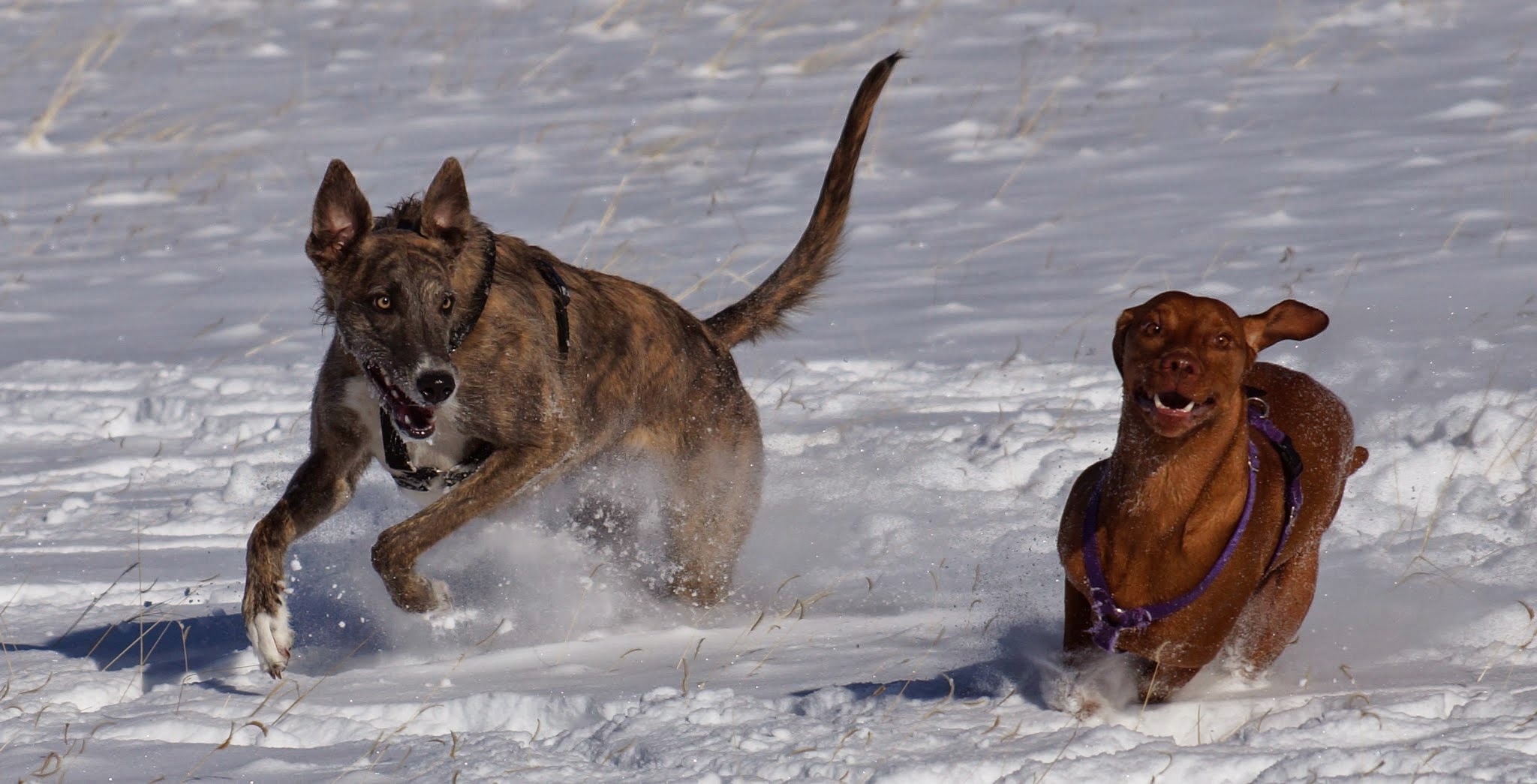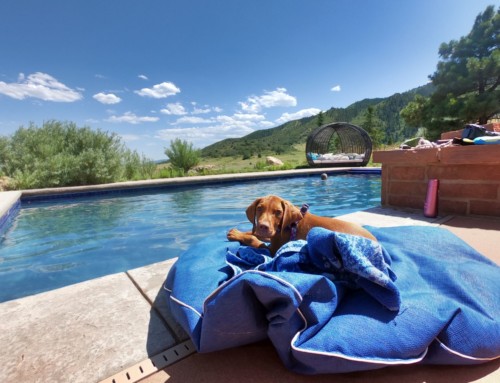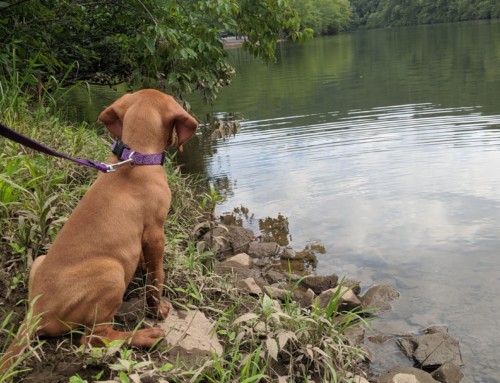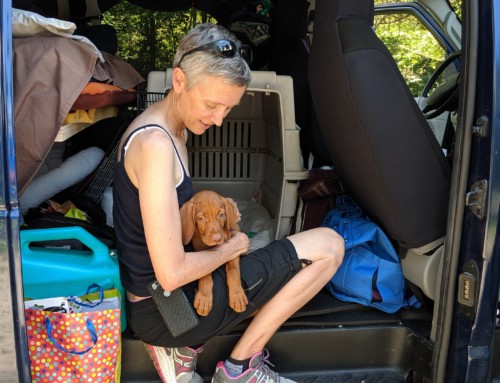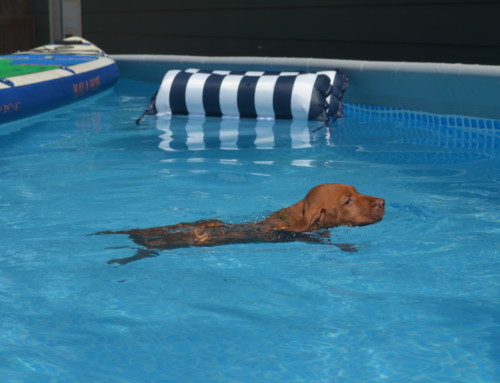DOG TRAINING OFFERED IN-PERSON AND ONLINEOur dog training services are delivered in almost any format that meets your needs. We have GROUP CLASSES at our indoor and outdoor facilities on our farm, ONLINE LIVE STREAMING classes, and SELF-PACED VIDEO-BASED training through our Online Dog Training Course. Our PRIVATE TRAININGS can be done in-home, outside, in public dog-friendly locations, at our facility on our farm, online via phone or video conferencing and through email. |
Contents
Does the breed of dog matter for your adventures?
How to train your adventure dog
- Age and current condition
- The basic training needed for any adventure
- General Adventure Categories
- Walking on lead
- Walking off lead around local open spaces or parks
- Riding in car
- Hiking and Backpacking and Camping
- Running
- Biking
- Winter sports: Skiing/Snowshoeing/Backcountry
- Water sports/Water craft
- Motels, Hotels, Cabins and AirBnB's
- Plane travel
- Specific adventure categories
What is an adventure dog?
Defining an adventure dog is different to everyone.
Traditionally, we might think an adventure dog as one who is does a lot of outdoor-related activity with their owners.
But in reality, an adventure dog is what you define him/her to be.
It could be a dog that goes outdoors for skiing, backpacking, hunting, etc.
Or it could be you just want your dog to go with you on car rides, or walks around the neighborhood or your local parks.
So to encompass this wide range of activities, we think of an adventure dog as any that gets out with you away from the inside of your home or your yard.
Does the breed of dog matter for your adventures?
Yes, in general.
Let's say you want to do a lot of outdoor winter activities. As a result, you might want to look for a breed that is best suited for the winter snow and cold.
But “a lot” is the key to consider. Our Vizsla, Romeo, clearly prefered warm-weather. His breed was not designed for cold weather. We called him the solar puppy because one of his favorite things was to lie in the sunroom and soak up the warmth of the sun.
But he did just fine in the cold and snow for us because we knew his limitations and how to manage his needs. If we want to go snowshoeing and the weather is not expected to be sunny and calm and above 25 degrees, then we would not take him for any extended period of time.
Our Greyhound Zuzu is the exact opposite. She loves the cold and hates hot weather. She is one we can take snowshoeing for an extended period of time regardless of the conditions, but if it is going to be sunny and above 65 degrees, then we have to be careful that she gets rest breaks in the shade often. If it's too hot, we can't take her along.
All dogs have limitations. You just have to think about which limitations you are willing to work with and which one you cannot. While it's important to consider the breed (or breed mixes) you also need to look at the individual dog. Not every dog fits the perfect description of a particular breed.
Zuzu loves to lie in the snow to cool off from running around

And Romeo disliked the cold, especially when it was windy



How to train your adventure dog
Age and current condition
Age obviously has a lot to do with the type of adventure that your dog can do.
With young dogs, you need to be careful about overdoing it while joints are still developing. Limit running and jumping, especially on hard surfaces until growth plates are closed. This will depend on the breed, but in general it is 1-2 years – closer to 1 year for small breeds and 1.5-2 years for large breeds.
With senior dogs, be careful about overdoing it. Do they have trouble getting up or moving after the event? They might seem fine during the event but pay the price after. Some dogs will do everything they can to keep up with what you are doing even if they really are not able to do so. This will depend in part on what kind of shape your senior dog is in. If he's stayed very fit during adulthood and is still in great shape, you might not have any problems. However, if your dog has slowed down and not been getting as much exercise as he used to, then you will need to be more careful.
And you can't expect your dog to be ready to go without prior conditioning. Just like humans, you have to build your dog's endurance, which means consistently exercising them to prepare them for the event you have in mind. If you have a big event in mind, make sure you plan ahead. You would probably not jump in and run a marathon this weekend without having done months of prior planning and preparation. Make sure you don't try to get your dog to run his version of a marathon without prior prep as well.
And as always, you need to keep in mind any potential health issues that their breed is prone to develop, like arthritis or hip dysplasia.
Talk to vet for any precautions to take.
For signs that you might be overdoing it, please see the graphics above on hot and cold weather tips
The basic training needed for any adventure
If you are taking your dog on adventures, from walking around the block, to car rides, or to the great outdoors, here are the basics.
The first is to make sure your dog responds reliably to what you ask. Whether that is sit, stay, come, or some other cues, the specific cues will depend to some degree on what activities you plan to do. But is the ability to focus and respond quickly there? If not, you have some prep work to do!
The second is to stay tuned in. If you’re away from home, it’s critical that your dog learn to stay tuned in to you and know where you are. Let’s say you plan to always have your dog on leash and don’t think you need off leash reliability. But what happens when your dog’s leash breaks, or you drop the leash, or he sees a rabbit just as you open the car door, or any number of circumstances that can and will happen when your dog suddenly is not on leash? The goal if travelling a lot should be for off leash reliability even if you never plan to use it, because you never know when you will need it. And it will be all the more critical if you are away from home in unfamiliar territory.
A primary exercise that is the basis for a reliable response and staying tuned in is eye contact or a Watch Me exercise. Our dogs learn that eye contact is the best way to ask permission for things or to do things. It’s the best way to ask for help if they are unsure about something. It’s the best way to connect back and tune in with us. We spend more time on eye contact than any other thing in the early stages of our training. When people met our Vizsla, Romeo, they always commented on how tuned in he was with us. They were amazed at his focus on us. That did not come naturally! We worked hard on that, but we felt confident taking him lots of places because of that. He was always aware of where we were and never strayed far.
When asked what is most important, our students often say a reliable Come is the top of their list. We tell them that we disagree. We think connection (for us, that comes through eye contact) is our most critical skill for off leash adventures. Our philosophy is that if our dogs are tuned in with us and staying connected, we rarely ever need a reliable Come since they do not take off in the first place. While we certainly do want a reliable Come, we don’t want to need it very often.
Impulse control is another. Whether that is a Wait or a Stay or something else, the point is that if our dog cannot control his impulse to race off every time he gets excited about something, he’s not going to earn off leash privileges. And travelling is going to be more difficult. One of the first ones we teach is door manners or a Wait at all doors, gates, car doors, etc. Any time we are moving from one situation/location into another, our dogs have learned to connect on both sides so we can ensure it’s safe to proceed. This also helps prevent dogs from door darting. This can be especially dangerous when travelling if your dog darts out an unfamiliar door and takes off into unfamiliar territory.
General Adventure Categories
The following cover all-around general adventures, which would include more specific adventures. For example, Skijoring would be an element of winter sports and skiing. We just covered three of the basics:
- Reliable response;
- Stay tuned in;
- Impulse control.
But more specific training that we recommend for the activities below are listed.
Walking on lead
- “Leave it” so they do not pick up something foul or get into something dangerous;
- Loose leash walking or great leash manners makes walks much more pleasant for everyone.
Walking off lead around local open spaces or parks
- Socialization so they can behave themselves around other dogs;
- A reliable come;
- A reliable wait before you let them go visit another dog, greet a person or check out something interesting;
- “Leave it” so they do not pick up something foul or dangerous.
Riding in the car
- Crate training so they are safe and comfortable going in and out of crates with ease (especially jumping up into or down from vehicles) and can stay in for long periods of time.
Hiking and Backpacking and Camping
- “Leave it” so they do not pick up something foul or dangerous or chase after wildlife;
- Loose leash walking makes walks more pleasant;
- A reliable come;
- They might be raring to go, but you are still fiddling with your backpack or taking a water break, so a reliable wait is handy to have;
- A strong stay they can hold for a long time so you can focus your attention elsewhere (like setting up camp);
- Loose leash walking so if they need to be on leash, they are not pulling you on the trail;
- And of course, reliable sits or downs that they can hold for short periods.

Running
- Heel so they stay at your side on a loose leash
- Leave it so they do not make a sudden turn to chase something and send you tumbling
Biking
- Safety is the biggest issue here. You want your dog close but not necessarily heeling and you do not want them to get in front of you. We train our dogs to respond to “side”, which means, stay at my side, not in front and not in back.
Winter sports: Skiing/Snowshoeing/Backcountry
Any kind of skiing, like biking, is a safety issue, so teaching “side” is advantageous for this sport. For other slower snow sports like showshowing and backcountry, follow the items listed above under Hiking and Backpacking and Camping
Water sports/Water craft
A lot of dogs may be uncomfortable around water and especially in moving water craft that are open. You might include other open vehicles like topless cars or all-terain vehicles. The biggest element of training here is to get them use to riding in these types of water craft or vehicles. We talked about conditioning above, but mental condition is just as important. After that, you want a strong stay and down so they remain where they are to keep them safe from jumping out.
Motels, Hotels, Cabins and AirBnB's
We teach our dogs “default” locations. At home, when they are young, their crate is one of those locations. When in doubt, the best place to show up is one of your “default” locations. Mat training is a good default. We have travel mats (they look sort of like a sleeping bag) that we always bring on our road trips. If we are staying with family, renting a cabin, staying in a hotel, etc., we bring in the mats and set them down wherever I want my dogs to lie down. They know that is their spot. If our dogs want something or are feeling unsure, going to a “default” location is a good bet.
Plane travel
We personally would never recommend plane travel where they are separated from you. That just brings in a whole level of stress when they have to travel through baggage and may not be safe with the way airlines handle baggage.
But if they are with you, then training them to be comfortable flying in planes and staying in crates for long periods are the most important things.
Specific adventure categories
There are so many other adventure categories, like Hunting Sports/Retrieving/Tracking, Equestrian, Herding, Rappelling/Skydiving, Mushing, and many others that require specific types of training. But they still need most, if not all the basics that we listed above.
The adventure dog food program
Food will fuel your dog and you absolutely need the right food.
First, absolutely, positively DO NOT feed kibble. Actually, this goes for any dog, adventure or not. Research is abundantly clear that dry kibble is like feeding cancer to your dog. Please click here for an excellent video documentary series on cancer and pets that interviews leading researchers and veterinary doctors about the epidemic we have in cancer, diabetes and other diseases in pets, their causes and cures.
For the highest quality raw dog food, please consider ours that we produce on our farm in our USDA licensed kitchen.
But you should really consider making your own, which we were shocked at how easy it was to do once we learned how. We have made it easy for you to learn as well with our Raw Dog Food Preparation Video & Guide

We have a lot of resources about healthy food for dogs throughout our website, but it is all rolled up into our resource guide, How to Make Healthy Food Choices For Your Dog. This resource guide is free to our repeat customers, so please contact us for free access.
Core food for a healthy adventure dog
A raw food diet consisting of 60% muscle meats, 15% organ meats, 15% vegetables, 5% fruit and 5% for other whole food supplements is all that most adventure dogs need.
These are the ratios science tells us that dogs need. That is what we feed our dogs and how we have modeled our Food Stack For Dogs program for feeding dogs that we developed from our research. We use our Food Stack to develop foods for our dogs that we also sell here at The Light of Dog.
Their main meals should comprise at least 80% of their diet, with treats, chews, and supplements the other 20%.
But actually, if all you fed were main meals and nothing else, that is perfectly fine, too. As long as your treats, chews and supplements stay within the 60-15-15-5-5 ratios above, you are good.
However, having a good high quality treat handy in your bait bag can be useful for recalls and to keep your dog's attention on you. Ones like our Peak Power Dog Treats are very healthy, stay within the ratios above and are very flavorful because they are mostly high quality meat. As a result, we find it is really easy to keep our dog's attention when on an adventure and only need a very small amount, so our treats last us a long time.
Feeding while traveling
If you are not in a position to take your raw dog food with you during travel, then look for equivalent freeze dried that are easy to pack and lightweight and easy to re-hydrate with water.
If that is not available, then in these circumstances, we will consider the highest quality dry kibble you can buy. If you need help choosing dry kibble, please consult our resource guide, How to Make Healthy Food Choices For Your Dog. If you are a repeat customer of ours, please contact us to get free access.
Equipment basics for your adventure dog
We always have spare equipment along. Collars or harnesses, especially, can break or get chewed through. Leashes can break or get chewed through. Sometimes we encounter loose dogs who have escaped their collars or leashes. We try to have spares along in case of emergency.
We always have spare bowls in the vehicle for food or water in case we forget to pack our regular bowls.
Microchipping and IDs
It is a very good idea to have your dog microchipped, period.
For ID tags, make sure you include all identification so someone can easily reach you quickly.
And be sure to periodically check that the ID tags have not worn out any of the identification. We see it all the time that metal tags get so worn down you cannot read the information.
Crates & Bedding
For vehicles, at least, we take plenty of extra bedding for dogs to relax on. This includes extra blankets for them to hang out outside the vehicle if we are sitting outside.
Our adventure vehicle is a full size van with enough space for crates and equipment
We always put our dogs in crates when traveling because it is much safer. And make sure to strap the crates down securely to prevent them from moving should you be driving in a bumpy off-road or have an accident.

Collars, harnesses and leashes
We use harnesses on our dog and not collars. Our ID tags are attached to the harnesses. Because our dogs are off leash so often, and because they sometimes run off into scrub oak or bushes, we never use collars that could possibly strangle our dogs if caught on a branch. Harnesses provide something to easily grab hold of in case of emergency and to attach leashes to when needed.
Whether using collars, harnesses or head halters, be sure they are properly fitted. If a collar is too tight, your dog cannot breathe properly. If it is too loose, it is easy to accidentally slip out of it. For dogs with narrow heads, such as Greyhounds and others, if you are using a collar, you might want to use a Martingale or limited slip collar that prevents them from backing out of it. Make sure collars cannot strangle your dog if caught on something – one of many reasons to never use choke chains. Keep in mind that many dogs can slip out of many types of harnesses as well.
The leashes or long lines that we use when first getting going or in places where we need dogs leashed up use carabiners to attach to their harnesses, not clips. We have seen clips break or accidentally unclip. We always use carabiners that secure so we are less concerned about equipment failure.
This video explains exactly what we do and why.
Water Supply
We pack water in camelbacks and always take far more than we think we will need. Besides for drinking, water can be use to cool dogs off and to wash them off if they get into anything or to help clean out eyes that may happen to get something in them.
Poop Bags
Pack plenty of these, too. We have found that poop bags can have holes in them or be flimsy and break apart easily, especially the biodegradeable ones, which we all should be using anyway. But pack extras or double layer them because we cannot tell you how many times they have broken, either while using them, or after use when they are sitting in our packs. Don't risk getting a surprise if a bag breaks while finding a proper place to dispose of it.
Equipment Belts
We have assembled our own belts that allow us to easily keep various items hooked to them so we do not have to remember to grab them every time we go out with our dogs. They include poop bags, citronella or pepper spray for safety, collapsible water bowl, extra lead, treat bag, large general storage bag (like used poop bags) and extra carabiner to easily hook the dog's lead.

Additional equipment
There is a myriad of additional equipment you can get for your dog depending on the activity, from coats to backpacks to shoes and more. All of that really depends on the activity and your personal preferences, but just do your research to find equipment that won't cause blisters, cause them to overheat or get it snagged on something.
Our goal is to positively impact the lives of as many dogs and their families as we can, in part through our extensive library of video, infographics and text articles. 
|

